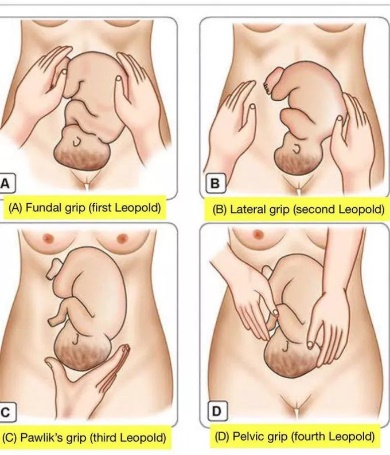A nurse in a prenatal clinic is caring for a client. Using Leopold's maneuvers, the nurse palpates a round, firm, movable part in the fundus of the uterus and a long smooth surface on the client's right side. In which abdominal quadrant should the nurse expect to auscultate fetal heart tones?
Left lower
Right upper
Right lower
Left upper
The Correct Answer is B
Choice A reason:
The left lower quadrant is not typically where fetal heart tones are auscultated when the round, firm part of the fetus (usually the head) is palpated in the fundus and the long smooth surface (indicative of the back) is on the right side. Fetal heart tones are best heard through the back of the fetus, and in this position, the back is not located in the left lower quadrant.
Choice B reason:
The right upper quadrant is the correct location to auscultate fetal heart tones in this scenario. The Leopold's maneuvers suggest that the fetus is in a cephalic presentation with its back facing the right side of the mother's abdomen. Therefore, the fetal heart tones are most likely to be heard in the right upper quadrant, just below the level of the fundus.
Choice C reason:
The right lower quadrant is generally not the area to auscultate fetal heart tones if the fetus's back is on the right side and the head is in the fundus. The heart tones are typically higher up and closer to where the back is palpated.
Choice D reason:
The left upper quadrant would not be the correct place to find fetal heart tones given the described position of the fetus. With the back on the right side, auscultation on the left would not yield the clear heart tones expected.

Nursing Test Bank
Naxlex Comprehensive Predictor Exams
Related Questions
Correct Answer is D
Explanation
Choice a reason:
Limiting alcohol consumption is important during pregnancy to prevent fetal alcohol syndrome and other developmental issues, but it is not specifically related to the prevention of neural tube defects. Alcohol can interfere with the body's ability to absorb certain nutrients, but folic acid intake is the key factor in preventing neural tube defects.
Choice b reason:
Avoiding foods containing aspartame is often recommended for overall health, but there is no direct link between aspartame and neural tube defects. Aspartame is an artificial sweetener found in many diet foods and beverages, and while some people choose to avoid it for various health reasons, it is not specifically associated with neural tube defects.
Choice c reason:
Increasing the intake of iron-rich foods is crucial for preventing anemia during pregnancy and ensuring the baby has enough iron stores. However, iron does not play a direct role in the prevention of neural tube defects. Neural tube defects are related to folic acid, not iron.
Choice d reason:
Consuming foods fortified with folic acid is the most critical factor in preventing neural tube defects. Folic acid is a B vitamin that is essential for the proper development of the neural tube, which becomes the baby's brain and spinal cord. Adequate folic acid intake before conception and during early pregnancy can significantly reduce the risk of neural tube defects.
Correct Answer is ["0504"]
Explanation
To calculate the estimated date of birth (EDB), also known as the due date, we use Naegele's Rule, which involves adding one year, subtracting three months, and adding seven days to the first day of the last menstrual period (LMP). Using this rule, if the LMP was on July 27, the EDB would be:
- Add one year: July 27, 2024
- Subtract three months: April 27, 2024
- Add seven days: May 4, 2024
Therefore, the EDB in MMDD format is 0504.
Reason:
Naegele's Rule is a standard way of calculating the due date for a pregnancy. The rule estimates the expected date of delivery (EDD) by adding one year, subtracting three months, and adding seven days to the date of a woman's last menstrual period (LMP). This calculation assumes a regular menstrual cycle of 28 days and ovulation occurring on the 14th day of the cycle. The EDB is typically set at 40 weeks from the LMP, which is approximately 280 days. While this method provides an estimate, only about 4% of births occur on the exact due date, and most births occur within a range of two weeks before or after the estimated due date.
It's important to note that the EDB is an estimate and can be influenced by factors such as the length of menstrual cycles, the exact day of ovulation, and the date of conception. Ultrasounds and other prenatal tests can provide additional information to refine the due date estimate as the pregnancy progresses.
Whether you are a student looking to ace your exams or a practicing nurse seeking to enhance your expertise , our nursing education contents will empower you with the confidence and competence to make a difference in the lives of patients and become a respected leader in the healthcare field.
Visit Naxlex, invest in your future and unlock endless possibilities with our unparalleled nursing education contents today
Report Wrong Answer on the Current Question
Do you disagree with the answer? If yes, what is your expected answer? Explain.
Kindly be descriptive with the issue you are facing.
